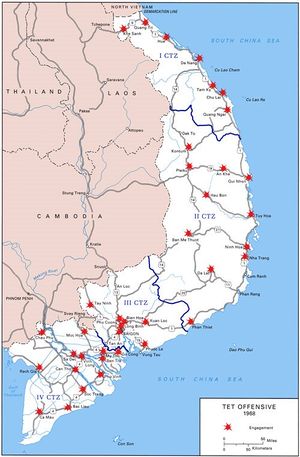Tet Offensive
On January 31, 1968, during the traditional cease-fire of the Tet holiday, Commuist forces attacked 36 of 44 provincial capitals and 5 of 6 major cities. It is unclear to which the Battle of Khe Sanh was part of an overall strategy to draw American forces away from the cities. Some agencies did not expect it, while others had suspected an oncoming offensive.
At the Central Intelligence Agency, Undersecretary of State Nicholas deB. Katzenbach and Assistant Secretary of State Philip Habib were being briefed about a suspected offensive, probably at the end of Tet, when the word of the first attacks came. [1]
North Vietnamese planners hoped to incite a popular uprising. [2] However, the Tet Offensive had a devastating impact on Johnson's political position in the U.S., and in that sense was a strategic victory for the Communists. [3]
Hue
The harshest fighting came in the old imperial capital of Hue. The city fell to the PAVN, which immediately set out to identify and execute thousands of government supporters among the civilian population. The allies fought back with all the firepower at their command. House to house fighting recaptured Hue on February 24. In Hue, five thousand enemy bodies were recovered, with 216 U.S. dead, and 384 ARVN fatalities. A number of civilians had been executed while the PAVN held the city.
Nationwide, the enemy lost tens of thousands killed, US lost 1,100 dead, ARVN 2,300. The people of South Vietnam did not rise up. Pacification, however, suspended in half the country, and a half million more people became refugees.
Media events
They avoided American strongholds and targeted GVN government offices and ARVN installations, other than "media opportunities" such as attempting to a fight, by a small but determined squad, of the U.S. Embassy. [4]
References
- ↑ Oberdorfer, Don (2001), Tet! The Turning Point in the Vietnam War, JHU Press,pp. 18-20
- ↑ Adams, Sam (1994), War of Numbers: An Intelligence Memoir, Steerforth Press
- ↑ Willbanks, James H. (2006), The Tet Offensive: A Concise History
- ↑ Oberdorfer, pp. 2-14
